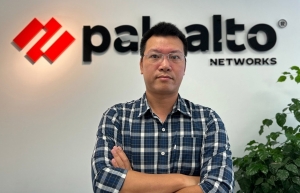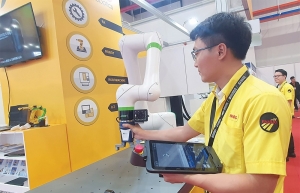Leveraging the power of artificial intelligence in telecoms
As networks are expanding in both scope and areas of usage, recent and emerging services are requiring always-on performance, ultra-reliability and low latency, high levels of security plus a network with the capability to support many diverse use cases. Networks are facing ever-increasing demands and requirements and rising expectations – from improving performance and capacity to lowering energy consumption.
 |
| Rita Mokbel, head, Ericsson Vietnam |
Beyond this, the network must also deliver a great experience for each service and user. At the same time, the evolution to 5G, the Internet of Things, and edge computing means the mobile ecosystem and networks are becoming ever more complex. We’re at a point where our networks simply must deliver value beyond just connectivity.
Here, advanced AI network technologies harness ever-powerful forms of machine learning and reasoning, generative AI, and more, to deliver on complex and diverse business goals, taking service providers closer than ever to fully autonomous intent-based networks with minimal human touch.
This is achieved by deploying AI agents within the network itself, replacing existing rule-based algorithms, adding new AI-based components with new functionality, or by adding AI-based controls to existing network components. These agents then leverage the massive real-time data generated by today’s networks to predict outcomes, detect anomalies, dynamically allocate network resources, optimise network quality of service, and more.
The emergence of cloud-native networks opens the entire network architecture to the possibilities of AI. Today, AI can be deployed across all network domains – from the network core to the RAN, and the network edge – and at every stage of the network lifecycle.
Some of the top AI use cases in telecom networks include customer and service experience. Cognitive tuning and optimisation technologies contribute to a superior user experience, reducing poor quality areas through right-on-time expansions, timely launch and proactive network optimisation. AI can also be deployed to improve customer service experience, with use cases that cover customer relationship management, channels, sales, and marketing.
To deliver cost efficiency, AI-based network planning and design leverages deeper analytics that can accurately predict needs. This includes high-accuracy traffic forecasts, KPI predictions, bottleneck identification, and load balancing opportunities across the network lifecycle. Through live radio measurement utilisation, such as subscriber traffic patterns, service providers can also ensure optimal 5G network expansion.
AI-based network diagnostics continually optimises and improves network performance and efficiency, scanning all network cells in minutes – identifying issues quickly and with high precision. This makes it possible to proactively identify 50 per cent more issues with up to 98 per cent field-validated accuracy, increasing operational efficiency by up to 30 per cent.
Meanwhile, through new innovative means and techniques, AI can enhance and automate the current security of 5G networks to detect zero-day attacks, as well as predict upcoming attacks, detect ongoing attacks, and test and deploy new defence mechanisms at run time.
AI is revolutionising the concept of network operations, taking service providers closer towards zero-touch end-to-end automation of the network. Step by step this is reducing manual operations, enabling improved business agility based on augmented decision-making and data-driven, predictive, and proactive operations.
There are some key benefits of AI for telecom networks that we are already seeing today. The niche in which AI truly thrives is in automating repetitive tasks, acting quickly and efficiently, and freeing up staff or resources to be used in other areas. By taking over routine tasks and enhancing network efficiency, AI-driven automation can optimise network operations and reduce costs.
Next, by leveraging AI, communication service providers (CSPs) can manage increased complexity, improving the customer experience while maintaining high network performance.
AI also opens a new paradigm of self-healing networks, enabling pinpoint accuracy of root cause detection and reducing time to resolution. When deployed at telecom sites, AI also reduces the need for hazardous field work, remotely notifying engineers about failures or predicted service degradations.
It can also improve the energy efficiency of networks, maximising network utilisation without impacting the performance of energy-saving features. AI can also act autonomously on real-time – or even predicted – traffic, helping CSPs reduce their energy consumption and lower their carbon footprint.
The impact of leveraging AI in networks is truly transformative; not only on network performance, but also in optimising and reducing costs, resources, and energy across the network, as well as unleashing future business possibilities.
 | New AI offerings pose more questions The AI explosion is continuing at pace with new offerings from the biggest tech groups in the world, but ethical concerns and investing considerations are taking up more focus as industries like the media and manufacturing adjust their priorities. |
 | Redefining the journalism landscape in the age of AI With the recent rise of AI, some journalists and media agencies are fearing an invasion where their journalistic work is used (sometimes without permission) as sources to generate personalised content, or to support social media users in their own quest to become opinion leaders. |
 | AI-powered solutions to be adequate response to threats Toying around with the latest generative AI tools has been entertaining for many. Yet, AI has long transcended personal use, profoundly reshaping organisational and business activities. |
 | Time is now for Vietnam to fully cultivate AI talent Vietnam is well-positioned to fully develop AI talent through government support, international collaboration, and an influx of foreign experts. |
 | Asia’s readiness for AI innovation: Lessons from South Korea’s digital transformation A landmark event to foster collaboration in AI research and development business across Asia by bringing together leading experts, scholars, government officials, and innovative communitie was held on July 11-12 in Hanoi. |
What the stars mean:
★ Poor ★ ★ Promising ★★★ Good ★★★★ Very good ★★★★★ Exceptional
Related Contents
Latest News
More News
- Takeda supports health resilience amid climate change challenges (December 18, 2025 | 12:39)
- Mondelez Kinh Do - a chapter of purpose-led leadership in Vietnam (December 18, 2025 | 09:44)
- VNPAY services receive the highest-level PCI DSS international security certificates for six consecutive years (December 17, 2025 | 23:47)
- PPL extends its reach into ASEAN (December 17, 2025 | 15:44)
- Over 600 BUV graduates meeting quality benchmarks across triple quality assurance levels (December 17, 2025 | 13:00)
- HEINEKEN Vietnam partners with Ho Chi Minh City Traffic Police on road safety drive (December 17, 2025 | 09:42)
- BUV and China’s CSCSE sign MoU to boost educational cooperation (December 17, 2025 | 08:00)
- PVT Logistics honoured with ‘Fast Enterprise Award’ at APEA 2025 (December 16, 2025 | 18:22)
- Empowering Sustainable Data Centers with Smart Infrastructure Solutions (December 16, 2025 | 13:59)
- Vietjet wins gold ESG transport sustainability award in Taiwan (China) (December 13, 2025 | 22:03)

 Tag:
Tag:






















 Mobile Version
Mobile Version